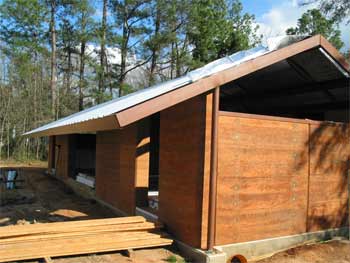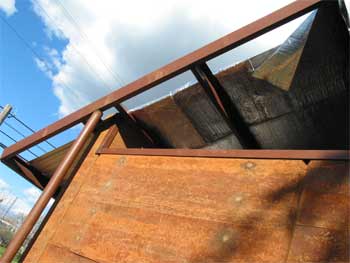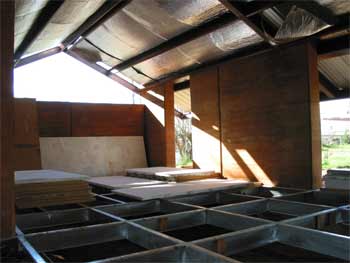The Auroville Earth Institute (AEI) was founded by the Government of India in 1989. The AEI aims to research, develop, promote and transfer earth-based technologies, which are cost and energy effective. These technologies are disseminated through training courses, seminars, workshops, publications and consultancy within and outside India. The main expertise is with Compressed Stabilised Earth Blocks (CSEB), but they also promote manual rammed earth and other earth based technologies
18th April: International Day for Monuments and Sites 2004: Earthen architecture and heritage
The International Day for Monuments and Sites was created on 18th April 1982 by ICOMOS and approved by the UNESCO General Conference. This special day offers an opportunity to raise the public’s awareness about the diversity of cultural heritage and the efforts that are required to protect and conserve it, as well as draw attention to its vulnerability.
Mud brick, rammed earth or other systems, one of the simplest material – earth – coupled with the skills of hands and minds, has produced an immense diversity of buildings, settlements or landscapes that constitutes a major but unknown part of our cultural heritage, to be found almost everywhere.
Getty Center Conservation Newsletter on Earthen Architecture
From the Getty Center Conservation Newsletter Volume 16, Number 1 – Spring 2001
The Conservation of Earthen Architecture by Alejandro Alva Balderrama
Conservation and Continuity of Tradition: A Discussion about Earthen Architecture with Anthony Crosby, Hugo Houben, John Hurd, Neville Agnew, Erica Avrami
Project Terra by Erica Avrami
Joya de Cerén: Conservation and Management Planning for an Earthen Archaeological Site by Carolina Castellanos, Françoise Descamps, and María Isaura Aráuz
Earthen Refrigeration

In a region where electricity is nonexistent and traditional clay pots are being replaced by aluminum and plastic containers, Mohammed Bah Abba has invented a clay pot in pot refrigeration system that, through evaporative cooling, dramatically extends the shelf-life of food.
Austrailian Earth-Building History
Read The history and conservation of pisé (Rammed Earth) buildings in the Australian Capital Territory written by Carol Cosgrove and Peter Dowling
Earthquake Tests on Earth Structures
Researchers from the Pontificia Universidad Católica del Perú have been studying the seismic stability of adobe and rammed earth and have developed measures to help combat the destructive forces that earthquakes have on earth buildings. Included in the site are several must see quicktime movies. [Spanish Language Web Site]
Alabama Rammed Earth



Designed by former students of the Rural Studio, this rammed earth house in Greensboro, Alabama has several interesting features. The walls of the house are not load-baring. The roof is supported by steel columns at the corners and the earth wall slides upwards between two steel beams on which the rafters sit. The floor is constructed with what seem to be foam sandwiched plywood flooring on large steel joists.
Earth Build 2005 Call For Papers
The Faculty of Design, Architecture and Building at the University of Technology, Sydney extends an invitation to all researchers/practitioners involved in earth building to submit papers for the EarthBuild 2005 conference. The conference will be held at the university campus on 19th and 20th of January 2005, with site visits planned for the 21st of January.
Those wishing to present a paper at the conference should submit an abstract of not more than 500 words with title and name of the author. Separately please provide us with your name and full contact details (address, organization, tel/fax, email etc.) as well as a short description of your involvement with earth building.
Contributions for a 20-minute oral presentation at the conference will be selected on the basis of the abstracts submitted. It is intended that refereed and non-refereed papers be presented at the conference and all contributions will be published in the conference proceedings.
The conference language will be English.
Closing date for submissions of abstracts for papers is 1st July 2004.
Abstracts and enquiries should be emailed to g.moor@uts.edu.au
Conference information will be regularly updated on the Earth Building Research Forum web page.
For more information contact:
Dr. Kevan Heathcote and Gregory Moor
Faculty of Design, Architecture and Building
University of Technology, Sydney
702-730 Harris Street, Ultimo
PO Box 123, Broadway 2007
tel. 61 2 95148837
fax. 61 2 95148828
Mud Brick Technical Manual
The ideal building material would be ‘borrowed’ from the environment and replaced after use. There would be little or no processing of the raw material and all the energy inputs would be directly, or indirectly, from the sun. This ideal material would also be cheap. Mud bricks come close to this ideal.
Robot May Build with Mud
In a laboratory in Los Angeles early this year, a robot armed with a concrete pump built its first wall. Just a small wall, about a yard wide, a foot high and an inch thick, but beautifully formed in a graceful oval sweep. Iranian born engineer Behrokh Khoshnevis has tested his prototype with cement but believes adobe, a mix of mud and straw that is dried by the Sun, could be suitable. The chief advantages of the Contour Crafting process over existing technologies are the superior surface finish that is realized and the greatly enhanced speed of fabrication. The success of the technology stems from the automated use of age-old tools normally wielded by hand, combined with conventional robotics and an innovative approach to building three-dimensional objects that allows rapid fabrication times. Professor Khoshnevis believes that his technology will make it possible to build a house from foundation to roof in less than 24 hours: “Our goal,” he says, “is to be able to completely construct a one-storey 185-square-metre home on site in one day, without using human hands.”
